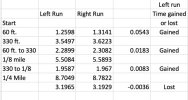Keith pretty much explained it here, just keep in mind ,if your car doesn’t pick the front tires off the ground, your never getting 100% of its weight on the rear tires for traction. His last line is spot on why we do this.Yes ideally wheels in the air “CAN” be lost time but Dave’s car is not set up to lay in the weeds next to the ground like a pro stock racer……it’s a gasser style car (straight axle) which means weight transfer…… and choosing to battle those demons also…….KOOOOOL
And if it came right down to fast as possible……. Our guys would not be running 409’s……. That to……. is it’s own battle…..!!!!
You are using an out of date browser. It may not display this or other websites correctly.
You should upgrade or use an alternative browser.
You should upgrade or use an alternative browser.
ROCK N RACE 2022 JULY 8-10
- Thread starter BRYAN FUGATE
- Start date
I think the low gear change could effect the 60 foot but help down track.
He just mentioned tranny???
Engine last year. The Mad Scientist will squeeze more out if it yet.
Keith is right! The short answer is for every one hundredth or thousandth of a second you cut off your short time it will carry through and come off the total elapsed time. Assuming no breakage. SO, Using Dave's numbers above the run had a 60' time of 1.2598 for a total E.T. of 8.7049. If he can better the 60 foot time to 1.20 flat the .0598 gained time should carry through to the finish line for a total E.T. of 8.6451. As Keith says if he can pick up more time between the 60' and eighth miles those gains become cumulative and reduce the total E.T. even more. If he can quicken his back half that is cumulative also. Hence, why Dave is comparing the 3.196 back half time for the run on the left to the 3.193 on the run on the right. The car actually slowed 3 thousands of a second in the back half on the faster run. Rumor has it Dave lifted!
Incrementals look like this:

As you can see the greatest gain (gain meaner quicker time) is in the short time. racers look at that because that's where they can have the most effect on the run.
Incrementals look like this:

As you can see the greatest gain (gain meaner quicker time) is in the short time. racers look at that because that's where they can have the most effect on the run.
Nice break down……me not smart like that…… professor……Keith is right! The short answer is for every one hundredth or thousandth of a second you cut off your short time it will carry through and come off the total elapsed time. Assuming no breakage. SO, Using Dave's numbers above the run had a 60' time of 1.2598 for a total E.T. of 8.7049. If he can better the 60 foot time to 1.20 flat the .0598 gained time should carry through to the finish line for a total E.T. of 8.6451. As Keith says if he can pick up more time between the 60' and eighth miles those gains become cumulative and reduce the total E.T. even more. If he can quicken his back half that is cumulative also. Hence, why Dave is comparing the 3.196 back half time for the run on the left to the 3.193 on the run on the right. The car actually slowed 3 thousands of a second in the back half on the faster run. Rumor has it Dave lifted!
Incrementals look like this:
View attachment 109142
As you can see the greatest gain (gain meaner quicker time) is in the short time. racers look at that because that's where they can have the most effect on the run.




de31168
Well Known Member
It is really all about balance and momentum. I haven't always had my best 60 foot time combined with my best et. Top speed can fluctuate too. I personally don't focus on the 60 foot time as much as i do the overall run and consistency. Your numbers can change by hundreths just in the way you stage the car. Every setup is different and the trial and error is a huge battle. Congrats Dave on those awesome passes and ETs!
So in all the racing he has never had a 8.70 ???? His very best time ???
Yes i believe this the first year Dave has hit the 8's and his best time so far more to comeSo in all the racing he has never had a 8.70 ???? His very best time ???





Bingo!!!! No wheel stands!!!Yes i believe this the first year Dave has hit the 8's and his best time so far more to come

Well his very best time was in a front engine dragster in the late 70s early 80s running in the mid to high sevens
In chevy 2 only is what I meant .Well his very best time was in a front engine dragster in the late 70s early 80s running in the mid to high sevens
